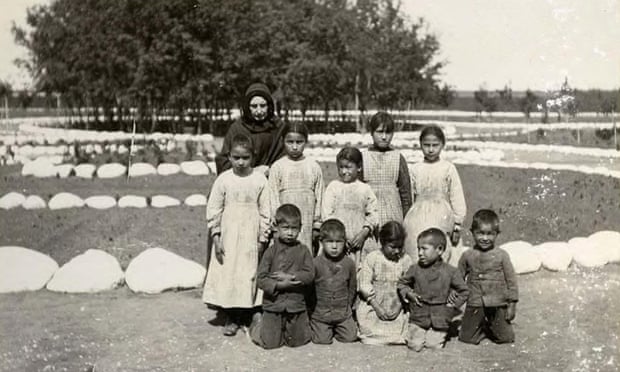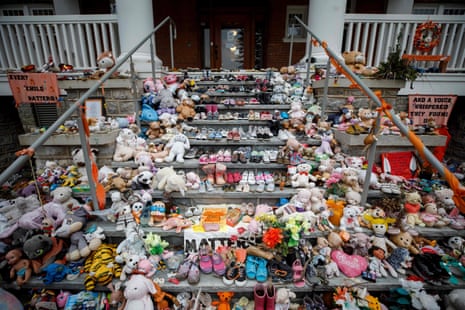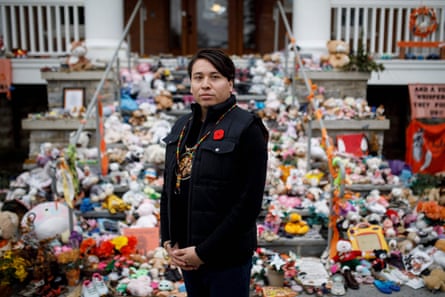The yellow tape of the police cordon snapped and fluttered as a chill breeze swept over the grounds of what was once one of Canada’s most notorious residential schools.
The entire 500-acre property is now being treated as a huge crime scene as the long-overdue search finally begins for the children who were sent to live here – but never returned home.
“I hope they find bodies because of what they did to us,” said Alfred Johnson, who attended the school in 1947. “They used us for slave labour.”
On Tuesday, police and community members at the Six Nations of the Grand River began searching the grounds of the Mohawk Institute – the oldest and longest-running residential school in Canada – as they launched a grim search for the remains of children who many believe were buried here in unmarked graves.
Between 1831 and 1970, thousands of Indigenous children were sent to the Mohawk Institute, as it was known, a red-brick building that sits at the end of a long, tree-lined drive.
In theory, the young students were given a modern education designed to help them integrate into mainstream Canadian society. But survivors of the school – dubbed the “Mush Hole” by survivors on account of its poor food and dismal rations – have long described the forced assimilation as a regime of terror, where children were subjected to verbal abuse, sexual assault and physical violence.
Using a pair of ground-penetrating radar machines, police officers and locals began the long-anticipated search after sunrise, scouring the grounds of what is now the Woodland Cultural Centre, a museum dedicated to teaching the public about the legacy of residential schools.
“The survivors are the ones that heard the whispered truths about where the babies and the children are buried,” said Kimberly Murray of the Survivors’ Secretariat, a group representing community members forced to attend the school. “We must honour them and listen to their words. Modern technology and fancy machines and devices can help us record the truth. But they can never replace the first-hand knowledge of our people.”
Over more than a century, at least 150,000 Indigenous children were taken from their families and forced to attend the schools, many of which were run by the Catholic church.
Quick GuideCanada's residential schools
Show

Canada's residential schools
Over the course of 100 years, more than 150,000 Indigenous children were taken from their families to attend state-funded Christian boarding schools in an effort to forcibly assimilate them into Canadian society.
They were given new names, forcibly converted to Christianity and prohibited from speaking their native languages. Thousands died of disease, neglect and suicide; many were never returned to their families.
The last residential school closed in 1996.
Nearly three-quarters of the 130 residential schools were run by Roman Catholic missionary congregations, with others operated by the Presbyterians, Anglicans and the United Church of Canada, which is today the largest Protestant denomination in the country.
In 2015, a historic Truth and Reconciliation Commission concluded that the residential school system amounted to a policy of cultural genocide.
Survivor testimony made it clear that sexual, emotional and physical abuse were rife at the schools. And the trauma suffered by students was often passed down to younger generations – a reality magnified by systemic inequities that persist across the country.
Dozens of First Nations do not have access to drinking water, and racism against Indigenous people is rampant within the healthcare system. Indigenous people are overrepresented in federal prisons and Indigenous women are killed at a rate far higher than other groups.
The commissioners identified 20 unmarked gravesites at former residential schools, but they also warned that more unidentified gravesites were yet to be found across the country.
Since May, Canada has been rocked by the discovery more than a thousand unmarked graves at the sites of church-run residential schools.
The Six Nations police chief, Darren Montour, said officers were working closely with survivors and community members to investigate the “heinous allegations” made about staff at Mohawk Institute.
Drawing on the stories shared by survivors, police have advised beginning the exhaustive search in an area behind the school where the stables were located.
“We’ve waited long enough. Survivors have been heard and dismissed long enough,” the Six Nations chief, Mark Hill, told the Guardian in an interview. “So it feels good to be where we’re at today, seeing uniformed police searching the grounds. This is the concrete action I’ve long talked about.”


Photograph: Carlos Osorio/Reuters
The search, prompted both by stories shared in the community and the string of grim discoveries at other former residential schools, has also led to renewed calls for the government to immediately release all relevant documents.
“No one can analyze and assess the records more quickly and accurately than the community themselves. The community lived through this attack on them. They do not need nor have they asked for the government to review records on their behalf,” said Murray. “The time has come for institutions to turn over all the records to communities now. No more hiding behind colonial laws.”
Painstaking work will be needed to accurately identify potential burial sites, and community leaders are keenly aware of the need for cultural sensitivity in the event any remains are found. Children from 20 different communities – each with their own cultures and beliefs – were sent to the Mohawk Institute over the years.
“We’re working with survivors and communities with very different cultures. We have Haudenosaunee. We have Anishinaabe. We Inuit children that attended,” said Murray. “There are bodies here. There are spirits here, and they want to move on.”


For John Elliott, a Six Nations member who attended the school in 1947, the search represents a critical step forward.
“We used to go to a survivor’s circle to share our stories. No camera, no phones. You just listened. And sometimes you couldn’t believe the stories you were hearing – but you knew they were true.”
Elliott, now 85, arrived with his brother at the school when he was only 10.
“I came here twice,” he said. “Because the first time I was sent here, I ran away on the first day, 13 miles home, on Christmas Eve. My grandfather said the government was sending here, but at the time I didn’t know what he meant.”
The children were forced to work on the sprawling farm run by the Mohawk Institute, milking cows, planting crops and tending to chickens.
“We had 3,000 egg-laying chickens, but all we got each morning was a single egg. Didn’t see anything else. They just sold all the rest,” he said.
Elliott had been brought up speaking Mohawk, but staff at the school chopped off his long hair when he arrived and forced him to abandon his culture and his mother tongue. “I can’t speak it any more,” he said. “If you were beaten as much as I was for speaking my language, you wouldn’t speak it either.”
Elliot survived countless beatings, but he has been haunted for decades by the whispered stories he would hear of other young boys who attended the Mohawk Institute but disappeared without a trace.
“It’s been a long time, but those responsible have known all along what was here,” said Elliott. “I’m glad to see them get started. We’ll just have to wait and see what they find. But I know it will be something”
